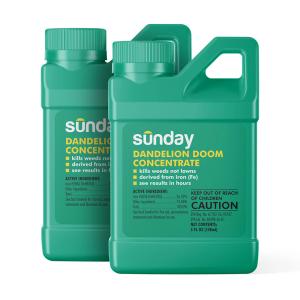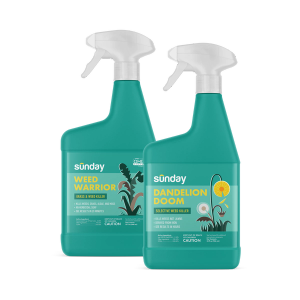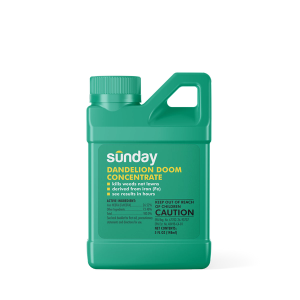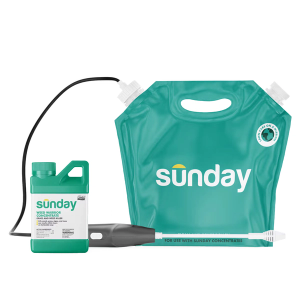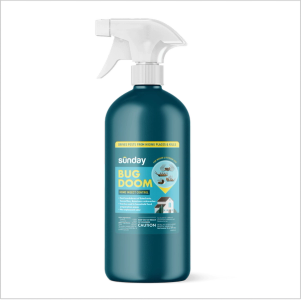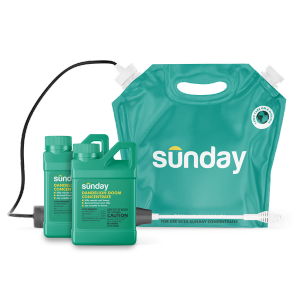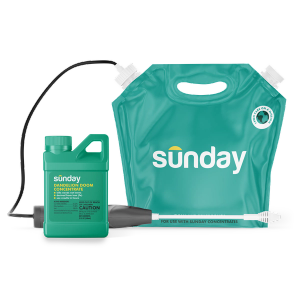What is crabgrass?
Crabgrass is an aggressive annual weed that can generate more than 150,000 seeds from a single plant. It emerges and establishes itself in spring, often getting ahead of your turfgrass during those busy weeks when lawn care isn't your top priority.
Crabgrass commonly sprouts along sidewalks, in areas where grass has thinned out, and takes advantage of any bare patches in your lawn - but don't be surprised to find it even in the most well-maintained lawns.
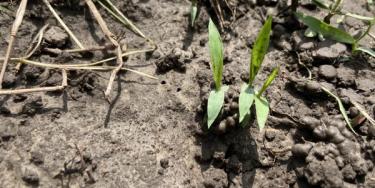
Why is crabgrass a big problem for lawns?
Crabgrass adapts well to both wet and dry growing conditions, giving it an edge during early spring. It spreads aggressively through lawns through root nodes and prolific seed production.
When the first frost kills the plants in fall, the resulting bare areas create perfect conditions for the next wave of weed seeds to establish. A frustrating, well-devised crabgrass cycle!
Sunday Tip:
Annual weeds like crabgrass don't just encourage more weeds — they also promote soil loss and erosion through exposing bare soil. By controlling annual weeds in your lawn, you also help protect local waterways.
How to get rid of crabgrass
Many aggressive, persistent herbicides can kill crabgrass, but there are also less harsh chemical methods that can be effective. Here's how to get rid of crabgrass without dousing your lawn in harsh pesticides.
Remove small patches manually
Manage weeds in early spring when crabgrass is small and before it has a chance to establish and spread.
Start with manual removal when possible, especially if you only have a few crabgrass plants that appear each season. Use a weeding tool (even a screwdriver works!) to extract small patches of crabgrass completely, including the root system.
Treat before emergence with Weed & Green
If you're controlling crabgrass in your lawn before it emerges, you likely know that it was a bigger weed issue last year.
Apply Weed & Green as a pre-emergent herbicide before crabgrass shoots emerge. Bonus: This fast-acting iron pre-emergent prevents crabgrass and other lawn weeds without harming your existing grass.
Best practices to apply Weed & Green
- Attach the hose and sprayer, turn on the water, and open the valve when ready to spray
- Apply evenly across the lawn, making sure to wet plants completely
- Let it dry thoroughly before returning to the lawn
- Use up to twice per year as a pre-emergent
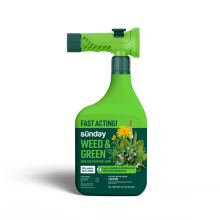
Weed & Green Pre-emergent and Post-Emergent Weed Killer
- Prevents crabgrass & weeds
- Controls weeds, moss & disease
- Greens up lawn quickly
- Easy hose-on application
- Covers 1,250 sq. ft.
Treat after emergence with Weed Warrior
Got a BIG patch of crabgrass that's already growing? Treat it with Weed Warrior. This fast-acting herbicidal soap eliminates unwanted vegetation, including crabgrass.
Best practices to apply Weed Warrior
- Apply according to the label, with repeat applications spaced 2-3 weeks apart for complete control
- Use with care on your lawn—it can harm any desirable grass or plants it comes into contact with
- After application, remove the dead plants and fill in areas with grass seeds or plants.
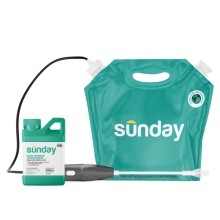
Weed Warrior Weed & Grass Killer - Starter Pack
- Kills grasses, weeds & more
- OMRI-listed herbicidal soap
- Fast-acting organic formula
- See results in 20 minutes!
Sunday Tip:
If you discover established crabgrass with seed heads already forming, it's often more practical to focus on prevention for the following season rather than attempting costly treatments on mature plants that have already spread extensively.
How to prevent crabgrass weeds
The number one way to prevent crabgrass from taking over your lawn is to get ahead of its spread. That boils down to treating it when it's small and following basic lawn care practices to grow a lawn that's more resistant to weeds.
Mow high
Maintain grass health and density by mowing high, removing no more than ⅓ of grass blades at any one time. Higher cutting heights reduce available space for weeds to establish.
Plant grass
Seeding grass into your lawn, or overseeding, is essential for crowding out crabgrass and other unwanted weeds. Do this 1-2 times annually in lawns that can be seeded.
For warm-season grasses like St. Augustine or Zoysia, use sod or plugs to repair thin areas of the lawn. Learn more about warm-season grass propagation.
Water correctly
Less frequent, deeper watering sessions encourage roots to grow deeper into the soil as they search for moisture. Pro Tip: This method will also help dry out more shallow-rooted weeds, such as crabgrass.
Psst. Learn the Sunday way to water your lawn!
Reduce soil compaction
Weeds often exploit lawn areas where grass struggles, particularly in compacted soils. Address soil compaction to help your soil get enough oxygen and nutrients for healthy grass growth.
Get a Sunday lawn plan
Feed your lawn the right stuff at the right time.
Let's get growing
Our lawn engine uses satellite data to map out your lawn size and determine things like average rainfall, common weeds, and pest activity.
Frequently asked questions about crabgrass
Does crabgrass come back every year? As an annual weed, individual crabgrass plants die each winter. However, the thousands of seeds they produce can germinate the following spring, creating the appearance that the same plants return year after year.
Can crabgrass be prevented completely? While complete prevention is challenging, maintaining thick, healthy turf through proper mowing, watering, and fertilization significantly reduces crabgrass establishment.
What are some natural methods to prevent crabgrass? We don't recommend these because they typically don't work—but if you must try, we won't stop you!
- Smother it. Cover the crabgrass weeds with a brick, tile, plate, or any object to block the weeds from getting sunlight. Wait 4 to 6 weeks for the crabgrass to be smothered to death. When the weed is dead, remove it. Then, rake the ground’s surface where the crabgrass was and reseed with quality turf seed.
- Pour boiling water on the weed. You can kill unwanted weeds by pouring hot, boiling water on and around them, up to a 3-foot radius, to get the root system. Be aware, though, that boiling water will harm and kill healthy grass and other plants around the crabgrass.
- Gardening vinegar. This all-natural method to kill crabgrass is a great option that won’t cause lasting soil damage. Simply spray the vinegar (5 percent acidity or higher) on the weed until it’s drenched. Repeat a few times over several days to a couple of weeks or until the crabgrass dies.







